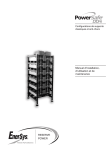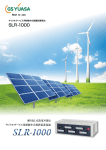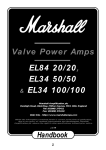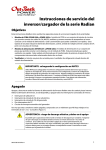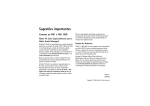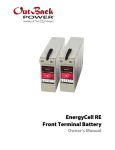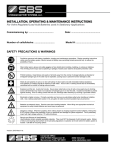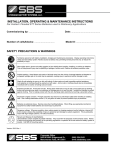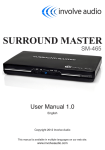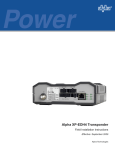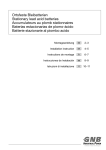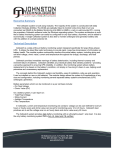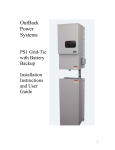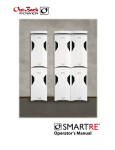Download EnergyCell OPzV Batteries
Transcript
EnergyCell OPzV Batteries User’s Manual About OutBack Power Technologies OutBack Power Technologies is a leader in advanced energy conversion technology. Our products include true sine wave inverters/chargers, maximum power point tracking charge controllers, and system communication components, as well as circuit breakers, accessories, and assembled systems. Contact Information Address: Corporate Headquarters 17825 - 59th Avenue N.E. Suite B Arlington, WA 98223 USA European Office Hansastrasse 8 D-91126 Schwabach, Germany Telephone: +1.360.435.6030 +1.360.618.4363 (Technical Support) +1.360.435.6019 (Fax) +49.9122.79889.0 +49.9122.79889.21 (Fax) Email: [email protected] Website: http://www.outbackpower.com Disclaimer UNLESS SPECIFICALLY AGREED TO IN WRITING, OUTBACK POWER TECHNOLOGIES: (a) MAKES NO WARRANTY AS TO THE ACCURACY, SUFFICIENCY OR SUITABILITY OF ANY TECHNICAL OR OTHER INFORMATION PROVIDED IN ITS MANUALS OR OTHER DOCUMENTATION. (b) ASSUMES NO RESPONSIBILITY OR LIABILITY FOR LOSS OR DAMAGE, WHETHER DIRECT, INDIRECT, CONSEQUENTIAL OR INCIDENTAL, WHICH MIGHT ARISE OUT OF THE USE OF SUCH INFORMATION. THE USE OF ANY SUCH INFORMATION WILL BE ENTIRELY AT THE USER’S RISK. Notice of Copyright EnergyCell OPzV User’s Manual © August 2015 by OutBack Power Technologies. All Rights Reserved. Trademark OutBack Power and the OutBack Power logo are trademarks owned and used by OutBack Power Technologies, Inc. The ALPHA logo and phrase “member of the Alpha Group” are trademarks owned and used by Alpha Technologies Inc. These trademarks may be registered in the United States and other countries. Date and Revision August 2015, Revision A Part Number 181-411-B0-001, Rev. A (08/2015) Table of Contents Important Safety Instructions . . . . . . . . . . . . . . . . . . . . . . . . . . . . . . . . . . . . . . . . . . . . . . . . . . . 5 Additional Resources . . . . . . . . . . . . . . . . . . . . . . . . . . . . . . . . . . . . . . . . . . . . . . . . . . . . . . 5 Delivery and Storage . . . . . . . . . . . . . . . . . . . . . . . . . . . . . . . . . . . . . . . . . . . . . . . . . . . . . . . . . 6 Receiving Inspection . . . . . . . . . . . . . . . . . . . . . . . . . . . . . . . . . . . . . . . . . . . . . . . . . . . . . . 6 Storage . . . . . . . . . . . . . . . . . . . . . . . . . . . . . . . . . . . . . . . . . . . . . . . . . . . . . . . . . . . . . . . 6 Unpacking and Handling . . . . . . . . . . . . . . . . . . . . . . . . . . . . . . . . . . . . . . . . . . . . . . . . . . . . 6 Installation . . . . . . . . . . . . . . . . . . . . . . . . . . . . . . . . . . . . . . . . . . . . . . . . . . . . . . . . . . . . . . . 7 Room and Installation Design . . . . . . . . . . . . . . . . . . . . . . . . . . . . . . . . . . . . . . . . . . . . . . . . . 7 Racks and Mechanical Stability . . . . . . . . . . . . . . . . . . . . . . . . . . . . . . . . . . . . . . . . . . . . . . . . 7 Cells in Parallel Strings . . . . . . . . . . . . . . . . . . . . . . . . . . . . . . . . . . . . . . . . . . . . . . . . . . . . . 7 Preliminary Inspection . . . . . . . . . . . . . . . . . . . . . . . . . . . . . . . . . . . . . . . . . . . . . . . . . . . . . 7 Electrical Connections . . . . . . . . . . . . . . . . . . . . . . . . . . . . . . . . . . . . . . . . . . . . . . . . . . . . . . 8 Instrumentation . . . . . . . . . . . . . . . . . . . . . . . . . . . . . . . . . . . . . . . . . . . . . . . . . . . . . . . . . 8 Operation . . . . . . . . . . . . . . . . . . . . . . . . . . . . . . . . . . . . . . . . . . . . . . . . . . . . . . . . . . . . . . . . 9 Charging . . . . . . . . . . . . . . . . . . . . . . . . . . . . . . . . . . . . . . . . . . . . . . . . . . . . . . . . . . . . . . 9 Commissioning Charge . . . . . . . . . . . . . . . . . . . . . . . . . . . . . . . . . . . . . . . . . . . . . . . . . . 9 Full Charge . . . . . . . . . . . . . . . . . . . . . . . . . . . . . . . . . . . . . . . . . . . . . . . . . . . . . . . . . . 9 Equalizing . . . . . . . . . . . . . . . . . . . . . . . . . . . . . . . . . . . . . . . . . . . . . . . . . . . . . . . . . . 10 Normal Operation Charging . . . . . . . . . . . . . . . . . . . . . . . . . . . . . . . . . . . . . . . . . . . . . . 11 Discharging . . . . . . . . . . . . . . . . . . . . . . . . . . . . . . . . . . . . . . . . . . . . . . . . . . . . . . . . . . . 12 Overdischarge Protection . . . . . . . . . . . . . . . . . . . . . . . . . . . . . . . . . . . . . . . . . . . . . . . . 12 Low-voltage Reconnect for Stand-Alone Systems . . . . . . . . . . . . . . . . . . . . . . . . . . . . . . . . . 12 Temperature Limits . . . . . . . . . . . . . . . . . . . . . . . . . . . . . . . . . . . . . . . . . . . . . . . . . . . . . . 13 Current Limits . . . . . . . . . . . . . . . . . . . . . . . . . . . . . . . . . . . . . . . . . . . . . . . . . . . . . . . . . . 13 Ripple Currents . . . . . . . . . . . . . . . . . . . . . . . . . . . . . . . . . . . . . . . . . . . . . . . . . . . . . . . . . 13 Battery Maintenance . . . . . . . . . . . . . . . . . . . . . . . . . . . . . . . . . . . . . . . . . . . . . . . . . . . . . . . . 14 Faults . . . . . . . . . . . . . . . . . . . . . . . . . . . . . . . . . . . . . . . . . . . . . . . . . . . . . . . . . . . . . . . . . . 15 Testing . . . . . . . . . . . . . . . . . . . . . . . . . . . . . . . . . . . . . . . . . . . . . . . . . . . . . . . . . . . . . . . . . 15 Taking Out of Operation / Storage . . . . . . . . . . . . . . . . . . . . . . . . . . . . . . . . . . . . . . . . . . . . . . . 15 Transport . . . . . . . . . . . . . . . . . . . . . . . . . . . . . . . . . . . . . . . . . . . . . . . . . . . . . . . . . . . . . . . 15 Performance Curves . . . . . . . . . . . . . . . . . . . . . . . . . . . . . . . . . . . . . . . . . . . . . . . . . . . . . . . . 16 Technical Specifications . . . . . . . . . . . . . . . . . . . . . . . . . . . . . . . . . . . . . . . . . . . . . . . . . . . . . . 20 Figures Figure 1, Expected Number of Cycles vs Depth of Discharge . . . . . . . . . . . . . . . . . . . . . . . . . . . . . . . 16 Figure 2, Guidance for the Initial Low-Voltage Disconnect Settings (25°C Reference Temperature) . . . . . . 17 Figure 3, Self-Discharge Characteristics . . . . . . . . . . . . . . . . . . . . . . . . . . . . . . . . . . . . . . . . . . . . 18 Figure 4, EnergyCell OPzV Cycle Life . . . . . . . . . . . . . . . . . . . . . . . . . . . . . . . . . . . . . . . . . . . . . . 19 Figure 5, EnergyCell OPzV Capacity vs. Temperature Chart (Rate = 120Hr/1.85VPC) . . . . . . . . . . . . . . . . 19 Tables Table 1, Case 1 . . . . . . . . . . . . . . . . . . . . . . . . . . . . . . . . . . . . . . . . . . . . . . . . . . . . . . . . . . . . . 9 Table 2, Case 2 . . . . . . . . . . . . . . . . . . . . . . . . . . . . . . . . . . . . . . . . . . . . . . . . . . . . . . . . . . . . . 9 Table 3, Case 3 . . . . . . . . . . . . . . . . . . . . . . . . . . . . . . . . . . . . . . . . . . . . . . . . . . . . . . . . . . . . 10 Table 4, Battery State Deviation . . . . . . . . . . . . . . . . . . . . . . . . . . . . . . . . . . . . . . . . . . . . . . . . . 10 Table 5, Settings for Stand-Alone Systems . . . . . . . . . . . . . . . . . . . . . . . . . . . . . . . . . . . . . . . . . . 11 Table 6, Functional Equalizing Frequency . . . . . . . . . . . . . . . . . . . . . . . . . . . . . . . . . . . . . . . . . . . 11 Table 7, Minimum Safe Temperature . . . . . . . . . . . . . . . . . . . . . . . . . . . . . . . . . . . . . . . . . . . . . . 13 Table 8, Performance Data - Discharge Constant Current at 20°C (Amperes) . . . . . . . . . . . . . . . . . . . . . 20 Table 8, Performance Data - Discharge Constant Current at 20°C (Amperes), Continued . . . . . . . . . . . . . 21 Table 9, Performance Data - Discharge Constant Power at 20°C (Watts/cell) . . . . . . . . . . . . . . . . . . . . . 22 Table 9, Performance Data - Discharge Constant Power at 20°C (Watts/cell), Continued . . . . . . . . . . . . . 23 Important Safety Information Important Safety Instructions READ AND SAVE THESE INSTRUCTIONS! This manual contains important safety instructions for the EnergyCell OPzV battery. These instructions are in addition to the safety instructions published for use with all OutBack products. Read all instructions and cautionary markings on the EnergyCell OPzV battery and on any accessories or additional equipment included in the installation. Failure to follow these instructions could result in severe shock or possible electrocution. Use extreme caution at all times to prevent accidents. WARNING: Personal Injury »» Some batteries can weigh in excess of 100lb (45kg). Use safe lifting techniques when lifting this equipment as prescribed by the Occupational Safety and Health Association (OSHA) or other local codes. Lifting machinery may be recommended as necessary. »» Wear appropriate protective equipment when working with batteries, including eye or face protection, acid-resistant gloves, an apron, and other items. »» Wash hands after any contact with the lead terminals or battery electrolyte. WARNING: Explosion, Electrocution, or Fire Hazard »» Ensure clearance requirements are strictly enforced around the batteries. »» Ensure the area around the batteries is well ventilated and clean of debris. »» Never smoke or allow a spark or flame near the batteries. »» Always use insulated tools. Avoid dropping tools onto batteries or other electrical parts. »» Keep plenty of fresh water and soap nearby in case battery acid contacts skin, clothing, or eyes. »» Wear complete eye and clothing protection when working with batteries. Avoid touching bare skin or eyes while working near batteries. »» If battery acid contacts skin or clothing, wash immediately with soap and water. If acid enters the eye, immediately flood it with running cold water for at least 20 minutes and get medical attention as soon as possible. »» Never charge a frozen battery. »» Insulate batteries as appropriate against freezing temperatures. A discharged battery will freeze more easily than a charged one. »» If a battery must be removed, always remove the grounded terminal from the battery first. Make sure all devices are de-energized or disconnected to avoid causing a spark. »» Do not perform any servicing other than that specified in the installation instructions unless qualified to do so. Additional Resources These references may be used when installing this equipment. Depending on the nature of the installation, it may be highly recommended to consult these resources. Institute of Electrical and Electronics Engineers (IEEE) guidelines: IEEE 450, IEEE 484, IEEE 1184, IEEE 1187, IEEE 1188, IEEE 1189, IEEE 1491, IEEE 1578, IEEE 1635, and IEEE 1657 (various guidelines for design, installation, maintenance, monitoring, and safety of battery systems) 181-411-B0-001, Rev. A (08/2015) 5 Delivery and Storage Delivery and Storage Receiving Inspection Inspect the shipment for missing components. Verify the contents with the packaging documents. Inspect each package or pallet for integrity and electrolyte leakage. Record the receipt date and the inspection results, and notify OutBack Power of any damage. Take photographs if necessary. Storage »» Store the batteries in a dry, clean, cool, and well ventilated location. Do not expose the cells to direct sunlight as damage to the container and cover may occur. »» Do not stack one pallet above the other. Avoid storing unpacked cells / monoblocs on sharp-edged supports. »» Storage on a pallet wrapped in plastic material is permitted except in rooms where the temperature fluctuates significantly, or if high relative humidity can cause condensation under the plastic cover. With time, this condensation can cause a whitish hydration on the poles and lead to high self-discharge by leakage current. »» Protect the batteries from any risk of electric shock resulting from short-circuiting by a conductive object or from a building up of conductive dust. »» It is recommended to have the same storage conditions within a batch, pallet or room. »» As the batteries are supplied charged, storage time is limited. In order to easily charge the batteries after prolonged storage, it is advised not to store them more than 6 months at 20°C, 4 months at 30°C, 2 months at 40°C. A refreshing charge is needed after this period. Failure to observe these conditions may result in significantly reduced capacity and service life. »» Record dates and conditions for all charges during storage. Unpacking and Handling 6 »» Never lift cells by the terminal posts. Lifting cells with weight above 25kg has to be made with lifting belts. Never drag or roll the battery. »» Do not apply force to the safety valve during handling. »» The batteries are fully charged before shipment. Do not short-circuit the batteries. »» Check for evidence of leakage. All cells with visible defects such as cracked jars, loose terminal posts, or other unrecoverable problems shall be rejected. 181-411-B0-001, Rev. A (08/2015) Installation Installation Room and Installation Design i Important: All aspects of the installation must be in accordance with the applicable rules and governmental regulations of the local area. »» The battery should be installed in a clean, dry environment. Avoid placing the battery in a warm place or in direct sunlight. The location or arrangement of cells should result in no greater than a 3°C temperature differential between cells within a series-connected string at a given time. Avoid conditions that result in spot heating or cooling, as temperature variations will cause the battery to become electrically unbalanced. »» Ensure the installation allows adequate air flow around each cell or monobloc for better cooling. Keep 10mm distance between cells or blocks. »» The layout of the room must allow easy access to the batteries. »» Provide adequate space and illumination for inspection, maintenance, testing, and cell/battery replacement. Space should also be provided to allow for operation of lifting equipment and proper measurement (cell voltage and temperature). Racks and Mechanical Stability EnergyCell OPzV battery racking is recommended for proper installation. Calculations should be made to ensure that floor loading capabilities are not exceeded. Seismic forces must be considered when applicable. The installation should provide adequate structural support and be as free of vibration as possible. Cells in Parallel Strings Valve-regulated cells may be connected in parallel to give higher current capability. In the case of parallel connected strings, use batteries of the same capacity, design and age only with a maximum of 4 parallel strings. If more than 4 strings are required, consult a technical support representative at OutBack Power. The resistance of the cables in each string must be the same. In addition, each string should be equipped with disconnect capabilities for maintenance and safety purposes. Preliminary Inspection 1. Check for evidence of leakage. All cells with visible defects such as cracked jars, loose terminal posts, or other unrecoverable problems should be rejected. 2. Before installation, if the surface of the battery container is dirty, wash the container with soapy water. 3. Conduct Open Circuit Voltage (OCV) measurements on each individual cell or monobloc battery to verify their compliance with the following variation and absolute voltage criteria: »» The OCV must not deviate from average more than ±0.025V for 2V cells. »» The OCV must not be lower than 2.05V for 2V cells. 4. Consult a technical support representative at OutBack Power if the battery compliance cannot be verified. 181-411-B0-001, Rev. A (08/2015) 7 Installation Electrical Connections 1. Ensure that the cells are wired with the correct polarity. 2. Verify that all contact surfaces are clean. If required, clean with a brass brush/pad. The inserts and connections can be lightly lubricated with silicone grease. 3. Torque the terminal screws to 22Nm. Note: For systems where the total battery voltage is measured at the controller, use oversized cables to the battery in order to minimize the voltage drop. 4. Electrical connections to the battery, as well as between cells on separate levels or racks, should be made to minimize mechanical strain on battery terminal posts. 5. Check the battery’s total voltage. It should match the number of cells / monoblocs connected in series. If the measurement is not as expected, recheck the connections for proper polarity. Batteries with a nominal voltage > 75V require an EC conformity declaration in accordance with the low voltage directive (73/23/EEC), which confirms that the CE marking is applied to the battery. The company installing the battery is responsible for the declaration and applying the CE marking. 6. For future identification, apply individual cell/unit numbers in sequence starting from one end of the battery. Also apply identification numbers for the parallel strings. 7. Connect the battery to the DC power supply, with the charger switched off, battery fuses removed and the load disconnected, ensuring that the polarity is correct. Instrumentation For large installations, consider permanent instrumentation for measurements and alarm. These include voltmeter, amp-meter, Ah counter, high and low voltage indicators, ground fault detector(s) and temperature sensor(s) for the battery and the ambient air. For smaller installations use portable test equipment. The temperature sensors must be fixed on the battery units (side wall or negative pole). 8 181-411-B0-001, Rev. A (08/2015) Operation Operation Charging Commissioning Charge The initial charge is critical to future battery operation and the battery’s service life. It is performed as a full charge (described in the next section). Keep the records in the battery’s logbook. Full Charge The full charge is a prolonged charge at elevated voltage, performed under the supervision of the user. It lasts until certain full charge criteria are fulfilled but not outside certain minimum and maximum duration limits. It is used mainly as a commissioning charge after installation, a corrective equalizing charge, a preparation charge before a capacity test, or a refresh charge during long storage period During charge, the battery temperature must be continuously monitored. If the battery temperature exceeds 45°C, the charge will be interrupted until the battery cools down. Case 1) With external charger of IU - characteristic. For the commissioning charge the current must be limited to 1*I10 Amps. Battery Temperature Voltage Settings Minimum and Maximum Charging Times 0 - 10°C 2.38 - 2.45V 48 - 72h 15 - 30°C 2.35 - 2.40V 36 - 72h 30 - 40°C 2.32 - 2.35V 24 - 48h Full Charge Criteria When the individual cell voltages have not risen for a period of 4 hours Table 1, Case 1 Case 2) With external charger of IUI or I - characteristic. Using an IUI or I charger that can charge the battery with constant current at elevated voltage, higher than 2.60Vpc up to 2.80Vpc. Bulk Charge Current Limitation 2.0*I10 Voltage Settings for U-Phase Gassing Charge Current Limitation 2.33 - 2.40V 0.12*I10 (1.2A per 100Ah Nominal Capacity) Minimum and Maximum Charging Times at Gassing Phase Full Charge Criteria 5 - 8h When the individual cell voltages have not risen for a period of 1 hour Table 2, Case 2 181-411-B0-001, Rev. A (08/2015) 9 Operation Case 3) Using the solar controller. Connect the battery to the controller and leave it for 1-2 weeks while the application load is disconnected. Full charge criteria are not applicable here. Use the following voltage settings: On-Off Controllers -20 - 0°C 0 - 35°C >35°C High Disconnect Voltage (Vr) 2.55V 2.45V 2.40V Low Restart Voltage (Vrr) 2.35V 2.30V 2.25V Constant Voltage Controllers -20 to 0°C 0 - 35°C >35°C Regulation Voltage (Vr) 2.45V 2.37V 2.33V Table 3, Case 3 Equalizing Functional Equalizing During a cycling operation, the target is to achieve an almost complete recharge (100% state of charge) after every discharge cycle, otherwise a permanent capacity decrease will threaten the battery’s service life. This is not always possible in stand-alone applications where the RES source depends on the weather conditions. A scheduled (functional) equalizing charge should be given at regular intervals to protect the battery from sulphation and lagging cells. »» Equalizing frequency is adjusted according to the charge deficit. The less complete the daily recharge is, the more frequent the equalizing is required. »» The charge duration is fixed. »» The voltage settings are the same values used for a normal recharge. Corrective Equalizing Equalizing charges are also required after incidents of excessive stress for the battery (deep discharges with inadequate charges) or when the individual cell or bloc voltages show excessive deviation from the average (lagging cells and sulphation problems). Should the voltage in individual cells/bloc deviate from the average value more than the following limits, perform an equalizing charge: Battery State 2V Cells Floating, after the first 6 months of operations -0.1V / +0.2V At end of normal charge, while the current is stable, after the first 6 months of operation -0.2V / +0.35V During discharge, while Depth-of-Discharge is between 5 and 20% ±0.04V During discharge, while Depth-of-Discharge is between 20 and 60% ±0.06V At rest, 24h after a functional equalizing charge ±0.025V Table 4, Battery State Deviation Corrective Equalizing is performed as a Full Charge If the voltages are still out of the limits, contact an OutBack Power technical support representative. 10 181-411-B0-001, Rev. A (08/2015) Operation Normal Operation Charging The following charging voltage settings are optimum values, so the battery is not heavily undercharged or overcharged. A good indicator to check this, is the percent of overcharge per cycle (charging factor) within a long period of operation (a month to a year). Deviations from these charging factors signals the user to check the charging settings and the overall system operation: »» >107% for Stand-alone systems with maximum daily depth-of-discharge less than 5% »» 105% to 110% for Stand-alone systems with maximum daily depth-of-discharge more than 5% Settings for Stand-Alone Systems The settings shall be adjusted according to battery temperature. Temperatures are averaged over one month: Controller Type Setting -20 - 0°C 0 - 15°C 15 - 35°C >35°C Constant Voltage One Step Vr 2.50V 2.45V 2.40V 2.35V Absorption Maximum 2h per Day 2.55V 2.50V 2.45V 2.40V Float 2.45V 2.40V 2.35V 2.30V High Voltage (Vr) 2.55V 2.50V 2.45V 2.40V Low Voltage (Vrr) 2.35V 2.30V 2.30V 2.25V Constant Voltage Two Steps On - Off Table 5, Settings for Stand-Alone Systems For systems with oversized PV array and low maximum daily depth-of-discharge (<5%), use lower settings. Functional equalizing charges are required in periods with marginal “Array to Load ratio” (less than 1.3). Typical frequency is 1 to 6 times per year. Absorption Time 4 - 6h 6 - 8h 8 - 10h 10 - 12h Equalizing Every 7 Cycles 14 Cycles 21 Cycles 28 Cycles If One Cycle = One Day One Week Two Weeks Three Weeks Four Weeks Table 6, Functional Equalizing Frequency A functional equalizing lasts 24 hours with voltage settings the same as above. 181-411-B0-001, Rev. A (08/2015) 11 Operation Discharging No restriction on the discharge current is required, provided the connections are properly sized and the battery temperature stays within the allowable limits. For discharge rates lower than I10, the maximum daily depth-of-discharge is expressed as a percentage of the C10 DIN value. The maximum allowable depth-of-discharge (MDOD) is 80% of the maximum available capacity, for all systems unless otherwise approved by OutBack Power. Overdischarge Protection The MDOD limit control should not be implemented solely through control systems based on Ah-counters. Monitoring the battery voltage against the low-voltage disconnect setting should always be included. The maximum daily depth-of-discharge limit control - for hybrid applications - can be measured either by Ah-counters control units or/and by battery voltage monitoring. The graphs at the end of this manual give the battery voltage to depth-of-discharge relation as a guidance for the initial low voltage disconnect settings (first-try settings). The system designer or installer must adjust and confirm them according to the actual conditions of the system. For systems where the voltage is measured at the controller and not on the battery, the voltage drop on the connections to the battery must be considered. For critical systems with the load directly connected on the battery, an alarm or other method of user feedback must be included to give information on the battery status when depth-of-discharge exceeds 60 to 80%. Low-voltage Reconnect for Stand-Alone Systems The battery voltage at which the load is reconnected after a low-voltage disconnect must be above 2.2 Vpc. 12 181-411-B0-001, Rev. A (08/2015) Operation Temperature Limits All technical data applies to the nominal temperature of 25°C. The ideal operating temperature range is 25°C ± 5°K. The recommended operating temperature range is 15°C to 35°C. Higher temperatures reduce the working life. A maximum temperature of 45°C must not be exceeded. In hybrid applications, the yearly average of battery temperature should be less than 30°C. Subzero temperatures may cause electrolyte freezing and irreversible damage when the battery’s state of charge is low. The minimum safe temperature versus state of charge is given below: SoC (% to C10 - DIN value) 0 - 20% 20 - 40% 40 - 60% 60 - 80% Freezing Point -40°C -30°C -20°C -15°C Table 7, Minimum Safe Temperature The system designer/installer should consider countermeasures like thermal insulation, increasing the battery capacity, or increasing the minimum system voltage. In stand-alone systems, it is recommended to use controllers with adjustable low voltage disconnect setting to the battery temperature (higher low voltage disconnect for lower temperature). During operation the temperature difference between individual cells/blocks battery should be below 3°C. Current Limits The maximum charging current during the bulk charging is 3*I10, while the battery voltage is below the gassing voltage of 2.40V x number of cells. Ripple Currents During recharging up to 2.40 V/cell, the effective value of the AC ripple current may temporarily reach maximum 10A/100 Ah C10 nominal capacity. After recharging and at float charge in stand-by operation or buffer operation, the effective value of the AC ripple current must not exceed 5A /100 Ah C10 nominal capacity. 181-411-B0-001, Rev. A (08/2015) 13 Battery Maintenance Battery Maintenance To avoid leakage currents and the associated risk of fire, keep the battery dry and clean. Clean with clear water; do not use any solvents or detergents as they can cause permanent damage to the container and lid. Avoid electrostatic charges. Measure and record the following parameters every 6 months: »» Battery voltage »» Voltage of some cells/bloc batteries (pilot cells) »» Temperature of the container in some cells/bloc batteries (pilot cells) »» Confirm daily depth-of-discharge per cell »» Confirm max depth-of-discharge per cell does not exceed the allowed limit »» Confirm charging factor is within acceptable limits »» Confirm that charge settings correspond to the recommended ones »» Check if corrective equalizing is applied Measure and record the following parameters every 12 months: 14 »» Voltages and temperatures in all cells/blocks »» Connectors, racks and the ventilation 181-411-B0-001, Rev. A (08/2015) Faults / Testing / Storage / Transport Faults Should faults be detected in the battery or the charging device, contact an OutBack Power technical support representative. Measured data will simplify fault detection and elimination. A service contract with OutBack Power will detect faults in time. Testing Tests must be conducted according to IEC 60896-21. Check that the battery is fully charged. Before testing new batteries it must be ensured that a sufficient commissioning charge has been applied and the battery is fully charged. Taking Out of Operation / Storage If filled lead acid accumulators are to be taken out of operation for a longer period of time, they must be placed fully charged in a dry, frost-free room. To avoid damage, periodical equalizing charging or permanent float charging must be conducted. Transport EnergyCell OPzV cells/monoblocks are protected against short-circuiting. If properly packed, batteries are not dangerous goods according to the international regulations for dangerous goods on road and on rail (ADR and RID). 181-411-B0-001, Rev. A (08/2015) 15 Performance Curves Performance Curves RES OPzV 2V Cells 8000 20 oC 25 oC 30 oC 35 oC 40 oC 45 oC Number of Cycles 7000 6000 5000 4000 3000 2000 1000 0 0% 10% 20% 30% 40% 50% 60% 70% 80% DoD % Figure 1, Expected Number of Cycles vs Depth of Discharge 16 181-411-B0-001, Rev. A (08/2015) 1.95 ric te d Us e 1.85 Re st ric te d Us e 1.90 Minimum for Standby Use Minimum for Solar Use DoD100% DoD90% DoD80% DoD70% DoD60% 2.00 st Battery Voltage (Vpc) 2.05 DoD50% RES OPzV 2V Cells DoD40% 2.10 DoD30% DoD20% Performance Curves 1.75 Re 1.80 Rates in Amps per 100AhC10DIN 0 10 20 30 40 50 60 70 80 90 t anno tery C re t a B e The ate H Oper 100 110 120 130 140 150 Extracted Amperhours per 100Ah of C10 DIN Figure 2, Guidance for the Initial Low-Voltage Disconnect Settings (25°C Reference Temperature) Note: »» The minimum voltage, for standby use, represents the maximum available capacity. »» The minimum voltage, for solar use, represents 80% of the maximum available capacity. It is the lower low voltage disconnect setting except in special applications and after OutBack Power’s approval. »» The depth of discharge 60% line, represents the minimum voltage setting to control the end of each discharge voltage in hybrid applications. It’s always recommended to implement a supplementary control by Ah counter. 181-411-B0-001, Rev. A (08/2015) 17 Performance Curves RES OPzV Cells 120% 10 oC 20 oC 30 oC 40 oC Residual capacity (%) 100% 80% 60% 40% 20% 0 5 10 15 20 25 Storage time (months) Figure 3, Self-Discharge Characteristics 18 181-411-B0-001, Rev. A (08/2015) Performance Curves Number of Cycles 8000 7000 6000 5000 4000 3000 2000 1000 0 20 10 30 40 50 60 80 70 Depth of Discharge (%) Available Capacity (% @ 25°C) Figure 4, EnergyCell OPzV Cycle Life 110% 105% 100% 95% 90% 85% 80% -10 -5 0 5 10 15 20 25 30 35 40 Temperature (°C) Figure 5, EnergyCell OPzV Capacity vs. Temperature Chart (Rate = 120Hr/1.85VPC) 181-411-B0-001, Rev. A (08/2015) 19 Technical Specifications Technical Specifications Performance Data - Discharge Constant Current at 20°C (Amperes) End Voltage 2.00V/cell 10h 12h 20h 24h 48h 50h 72h 100h 120h 168h 240h EnergyCell OPzV 450 14.73 12.98 8.99 7.86 4.59 4.45 3.30 2.51 2.12 1.55 1.10 EnergyCell OPzV 750 22.92 20.37 14.42 12.69 7.61 7.38 5.53 4.25 3.61 2.68 1.93 EnergyCell OPzV 2000 55.71 49.80 35.82 31.69 19.37 18.77 14.21 10.91 9.37 6.99 5.13 EnergyCell OPzV 3000 87.52 77.93 55.41 48.83 29.37 28.46 21.37 16.29 13.90 10.24 7.23 End Voltage 1.92V/cell 10h 12h 20h 24h 48h 50h 72h 100h 120h 168h 240h EnergyCell OPzV 450 25.17 21.86 14.54 12.52 6.99 6.75 4.92 3.67 3.11 2.29 1.63 EnergyCell OPzV 750 41.02 35.80 24.10 20.84 11.81 11.41 8.37 6.29 5.35 3.95 2.85 EnergyCell OPzV 2000 98.74 86.50 58.80 51.02 29.27 28.30 20.90 15.79 13.48 9.99 7.20 EnergyCell OPzV 3000 155.28 135.59 91.31 78.96 44.70 43.19 31.66 23.77 20.22 14.91 10.71 End Voltage 1.90V/cell 10h 12h 20h 24h 48h 50h 72h 100h 120h 168h 240h EnergyCell OPzV 450 27.17 23.55 15.59 13.40 7.44 7.18 5.22 3.89 3.29 2.41 1.72 EnergyCell OPzV 750 44.62 38.85 25.99 22.42 12.60 12.17 8.90 6.67 5.67 4.18 3.00 EnergyCell OPzV 2000 107.56 93.95 63.37 54.84 31.17 30.12 22.16 16.69 14.22 10.52 7.57 EnergyCell OPzV 3000 169.03 147.19 98.41 84.88 47.63 46.00 33.59 25.15 21.36 15.72 11.26 End Voltage 1.85V/cell 10h 12h 20h 24h 48h 50h 72h 100h 120h 168h 240h EnergyCell OPzV 450 31.09 26.87 17.64 15.13 8.31 8.01 5.79 4.29 3.63 2.65 1.88 EnergyCell OPzV 750 51.82 44.93 29.74 25.57 14.18 13.69 9.94 7.40 6.27 4.60 3.29 EnergyCell OPzV 2000 125.49 109.02 72.54 62.49 34.94 33.74 24.61 18.42 15.64 11.50 8.23 EnergyCell OPzV 3000 196.84 170.58 112.62 96.73 53.43 51.56 37.37 27.80 23.53 17.23 12.29 Table 8, Performance Data - Discharge Constant Current at 20°C (Amperes) 20 181-411-B0-001, Rev. A (08/2015) Technical Specifications Performance Data - Discharge Constant Current at 20°C (Amperes) End Voltage 1.83V/cell 10h 12h 20h 24h 48h 50h 72h 100h 120h 168h 240h EnergyCell OPzV 450 32.27 27.85 18.24 15.62 8.55 8.25 5.95 4.40 3.72 2.71 1.92 EnergyCell OPzV 750 54.06 46.81 30.88 26.52 14.64 14.13 10.23 7.60 6.43 4.71 3.36 EnergyCell OPzV 2000 131.15 113.73 75.35 64.81 36.03 34.78 25.30 18.89 16.01 11.75 8.40 EnergyCell OPzV 3000 205.55 177.84 116.94 100.30 55.11 53.16 38.42 28.52 24.11 17.61 12.54 End Voltage 1.80V/cell 10h 12h 20h 24h 48h 50h 72h 100h 120h 168h 240h EnergyCell OPzV 450 33.60 28.95 18.88 16.16 8.80 8.49 6.11 4.52 3.81 2.77 1.96 EnergyCell OPzV 750 56.70 48.99 32.16 27.58 15.14 14.60 10.54 7.82 6.61 4.83 3.44 EnergyCell OPzV 2000 138.00 119.36 78.56 67.43 37.21 35.91 26.03 19.38 16.41 12.02 8.57 EnergyCell OPzV 3000 216.00 186.41 121.83 104.28 56.91 54.87 39.53 29.27 24.72 18.02 12.81 Table 8, Performance Data - Discharge Constant Current at 20°C (Amperes), Continued 181-411-B0-001, Rev. A (08/2015) 21 Technical Specifications Performance Data - Discharge Constant Power at 20°C (Watts/Cell) End Voltage 2.00V/cell 10h 12h 20h 24h 48h 50h 72h 100h 120h 168h 240h EnergyCell OPzV 450 29.21 25.80 17.99 15.75 9.30 9.00 6.71 5.13 4.35 3.20 2.28 EnergyCell OPzV 750 45.36 40.39 28.78 25.39 15.37 14.90 11.24 8.65 7.41 5.53 4.03 EnergyCell OPzV 2000 110.20 98.72 71.43 63.31 39.17 37.98 28.94 22.30 19.27 14.47 10.76 EnergyCell OPzV 3000 173.36 154.64 110.66 97.66 59.30 57.62 43.40 33.45 28.45 21.08 15.06 10h 12h 20h 24h 48h 50h 72h 100h 120h 168h 240h EnergyCell OPzV 450 48.87 42.56 28.53 24.64 13.91 13.44 9.85 7.39 6.29 4.64 3.33 EnergyCell OPzV 750 79.3 69.47 47.14 40.88 23.42 22.65 16.71 12.62 10.78 8.01 5.80 EnergyCell OPzV 2000 190.87 167.69 114.94 100.03 58.07 56.19 41.77 31.74 27.17 20.27 14.70 EnergyCell OPzV 3000 300.49 263.14 178.68 154.96 88.75 85.82 63.31 47.80 40.78 30.23 21.84 End Voltage 1.92V/cell End Voltage 1.90V/cell 10h 12h 20h 24h 48h 50h 72h 100h 120h 168h 240h EnergyCell OPzV 450 52.50 45.65 30.46 26.27 14.74 14.24 10.41 7.79 6.62 4.87 3.50 EnergyCell OPzV 750 85.90 75.02 50.62 43.81 24.91 24.08 17.70 13.34 11.37 8.43 6.09 EnergyCell OPzV 2000 206.81 181.22 123.32 107.06 61.60 59.58 44.11 33.43 28.57 21.26 15.40 EnergyCell OPzV 3000 325.34 284.22 191.70 165.86 94.20 91.05 66.92 50.39 42.93 31.76 22.90 End Voltage 1.85V/cell 10h 12h 20h 24h 48h 50h 72h 100h 120h 168h 240h EnergyCell OPzV 450 59.52 51.60 34.18 29.40 16.33 15.77 11.46 8.55 7.24 5.31 3.80 EnergyCell OPzV 750 98.71 85.89 57.40 49.51 27.80 26.85 19.61 14.69 12.49 9.21 6.63 EnergyCell OPzV 2000 238.52 208.02 139.83 120.88 68.48 66.18 48.62 36.61 31.19 23.08 16.63 EnergyCell OPzV 3000 374.58 325.85 217.31 187.29 104.81 101.22 73.86 55.28 46.95 34.57 24.80 Table 9, Performance Data - Discharge Constant Power at 20°C (Watts/cell) 22 181-411-B0-001, Rev. A (08/2015) Technical Specifications Performance Data - Discharge Constant Power at 20°C (Watts/Cell) End Voltage 1.83V/cell 10h 12h 20h 24h 48h 50h 72h 100h 120h 168h 240h EnergyCell OPzV 450 61.59 53.34 35.24 30.29 16.77 16.18 11.74 8.74 7.40 5.42 3.87 EnergyCell OPzV 750 102.61 89.18 59.42 51.19 28.62 27.64 20.14 15.06 12.79 9.41 6.76 EnergyCell OPzV 2000 248.33 216.25 144.79 125.00 70.44 68.06 49.86 37.46 31.87 23.54 16.93 EnergyCell OPzV 3000 389.70 338.53 224.97 193.63 107.81 104.09 75.75 56.58 47.99 35.27 25.27 10h 12h 20h 24h 48h 50h 72h 100h 120h 168h 240h EnergyCell OPzV 450 63.90 55.26 36.39 31.21 17.22 16.62 12.04 8.95 7.57 5.53 3.95 EnergyCell OPzV 750 107.19 92.98 61.67 53.06 29.50 28.48 20.70 15.44 13.09 9.62 6.90 EnergyCell OPzV 2000 260.12 225.98 150.42 129.61 72.54 70.06 51.16 38.34 32.58 24.01 17.24 EnergyCell OPzV 3000 407.72 353.41 233.56 200.67 111.01 107.13 77.73 57.92 49.08 36.00 25.76 End Voltage 1.80V/cell Table 9, Performance Data - Discharge Constant Power at 20°C (Watts/cell), Continued 181-411-B0-001, Rev. A (08/2015) 23 Corporate Headquarters 17825 - 59th Avenue N.E. Suite B Arlington, WA 98223 USA 181-411-B0-001, Rev. A (08/2015) European Office Hansastrasse 8 D-91126 Schwabach, Germany
























